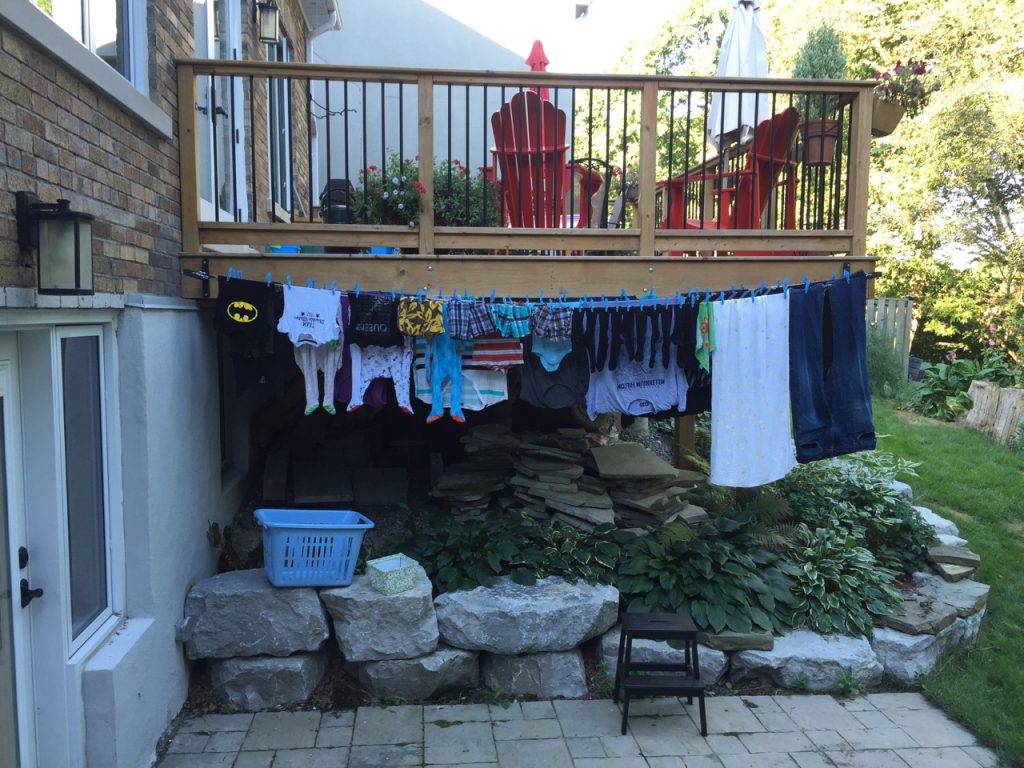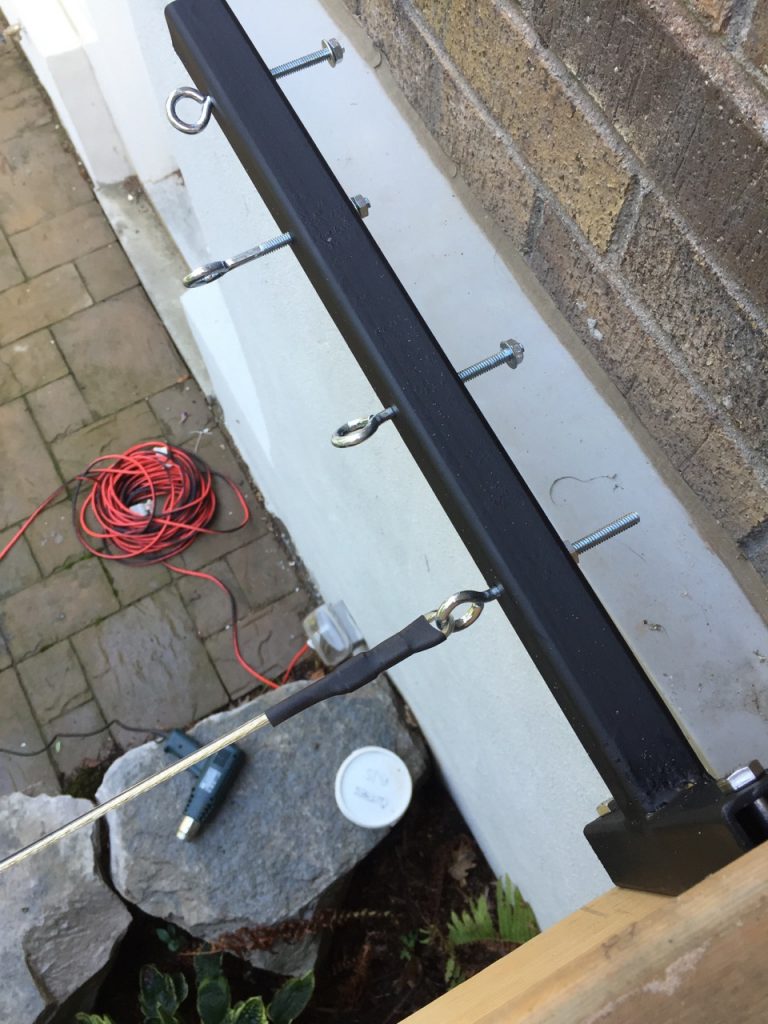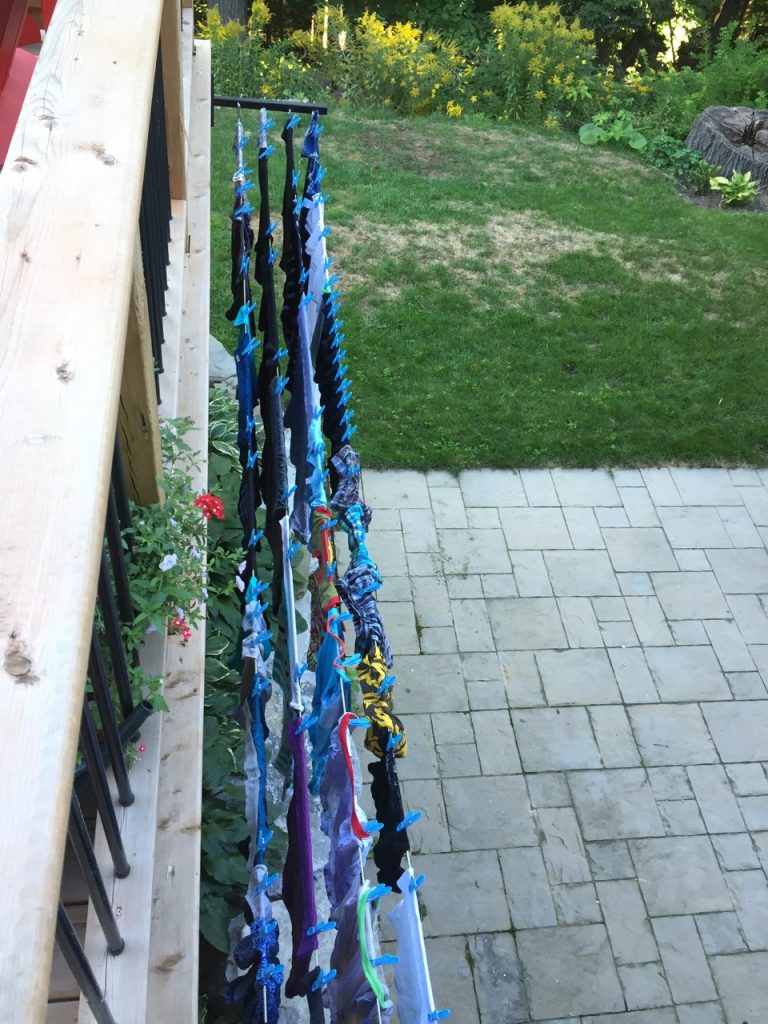When we moved into this house I swore I was going to put in a clothesline. It might have taken us three years, but we finally did it!
Clotheslines were actually illegal in Toronto until 2008, when the province voided all municipal bylaws that outlawed the practice of air drying clothes from ground-level dwellings (hello stupid laws that don’t make no sense).
I grew up with clothes dried on the line; using a dryer was reserved for the wettest and coldest seasons of the year, or those weeks in spring when everyone was spreading manure on the fields. Even then, clothes were often dried on racks or lines strung up in the basement. My folks (or maybe mostly my Dad?) were obsessed about keeping power costs down, and that was while power was much cheaper than it is today. Running a hog farm was an expensive business when you had exhaust fans running 24/7 to keep the piggies nice and comfortable. But I have to admit that for most of my adult life, I’ve been kind of addicted to the luxury and convenience of using my dryer.
We chose to install a gas dryer in this house, among several decisions we made to battle the ever increasing costs of electricity. But even natural gas is going up in price, and a gas dryer still uses electricity. Combine that with what feels like a quadrupling of our laundry requirements (how do such tiny people make so much laundry?), one of the hottest summers in memory, semi-privatization of electricity infrastructure and boom: you got yourself one heck of a hydro bill.

We had been thinking for some time of running a clothesline out to the big oak tree that marks the edge of the tree line on the ravine, behind our house. The problem though, is that the base of the tree is situated on a lower tableland than the back of the house. Meaning we’d have to somehow get a line very, very high up in that tree, negotiating innumerable branches (and did I mention it’s a ravine? As in, a not-so-flat ravine, ravine?) to get enough height that the house-end of the line would prevent, well, literally clotheslining someone. Not to mention it would cut right through the middle of the yard and be somewhat unsightly. We considered different angles, putting a pole up on the deck to get the line higher, and so on, but we just couldn’t find a solution that felt right.
Instead, for most of this summer I had been setting up a couple of racks on the deck to dry clothes. This has been working well except it’s a pain in the butt to set up the racks each time, then put them away. And trust me, you don’t want a toddler mucking about in your freshly hung clean laundry that’s so tantalizingly within reach.
Then I adjusted my technique and moved the whole arrangement to the back patio. This required some tidying, and this area of the yard doesn’t get a lot of sun, but it was a somewhat better arrangement. We had found a solution for our permanent clothesline installation, but it took some time to refine.
Chris welded up a set of brackets while we were at the farm one weekend (kudos to him for the welding, something he’s only got a small amount of experience in; I probably have more experience welding in general, but with a torch, and this was with an arc welder, which I’ve never used). He wasn’t terribly proud of his construction but he did a great job, and a little grinding smoothed out the edges. He drilled holes in the brackets to allow for the attaching of four clotheslines, hung about three inches or so apart. We found some little plastic end caps from Amazon to help keep water from accumulating inside the steel brackets, causing rust. Several coats of matt black spray paint and it was time to install.

Another delay ensued when Chris discovered that clothesline is kind of impossible to cut with conventional wire cutters or tin snips. The hardened steel inside the clothesline requires either bolt cutters or, in our case, a grinder. Thank goodness for that grinder.
The eye bolts were my idea. They allow for some finessing of how much you tighten each line, and offer some forgiveness if you happen to cut one piece of clothesline a little shorter than the other. The heat shrink wrap was Chris’s idea, to prevent clothing snags on the cut edge of the lines. So smart.

One thing Chris realized as he got the lines strung was that he should maybe have installed a support bracket on the inside of each side bracket, because as you tighten up the inside line, the outside line gets slack. To avoid too much of this, all the lines have a small amount of slack in them, which is fine as far as I’m concerned. I’ve used the new lines a few times now, often with heavy jeans, and they are holding up nicely.
I’m just thrilled with this. I can fit a really large load or a couple of smaller load on the lines. There is a total of about 60 feet of hanging space, which is great; I don’t know if we could have achieved that much line if we’d hung it in the tree. I still have the collapsable racks for really large loads. I set up the timer on my washer to run the load at around 4 or 5 a.m. so that it doesn’t have to sit in the machine and get smelly, and then I hang it out before I got to work.
One downside is that there is almost no sun exposure in this area, which slows drying time. But we looked at other ways to install (e.g. along the ravine-facing side of the deck) but this would have made for precarious footing for hanging clothes as it would be directly over some shrubbery that we planted last year, and it doesn’t have as much height clearance. Thankfully there is generally a good breeze coming off the Don Valley, so that helps. Heavier/thicker items will dry better if hung farthest from the house for maximum air flow.
We also might get some grief from our neighbours, because their main entrance now faces not only the underbelly of our deck where we store all kinds of odds and ends (they’ve voiced concern over this before) but also now, our laundry.
I guess I’ll need remember to hang our undies at the back.